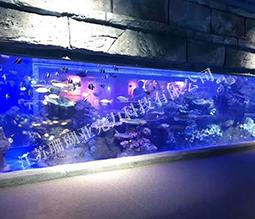Contact: Mr Zhou
Tel 18021802662 / 15317701002
Email: shanhuykl@163.com
Address: Yancheng City, Jiangsu Province,china

The requirements for lighting in the aquarium project are very important. What kind of lighting is used to achieve uniform light reception, thus making the acrylic fish tank more beautiful.
Halogen: In addition to the usual incandescent bulbs in acrylic fish tanks, another incandescent bulb is a halogen bulb. Among the halogen bulbs, a halogen gas, which may be bromine or iodine, is added. These halogen gases combine with the volatilized tungsten to form tungsten bromide, and tungsten iodide. Such a chemical reaction must be generated when the temperature is raised above 93oC (200oF). Although the brightness of a halogen bulb is 25% to 30% higher than that of a typical white light bulb, the amount of heat it emits has some effect on the water tank and needs to be carefully considered. Moreover, the space required for the chemical change of the halogen gas is very small, so the halogen lamp is usually small, but the outer bread serves as a larger glass bulb, mainly for heat insulation.
1. Acrylic contains a polar side methyl group, which has obvious hygroscopicity. The water absorption rate is generally 0.3%-0.4%. It must be dried before molding. The drying condition is drying at 80°C-85°C for 4-5h.
2. Acrylic has obvious non-Newtonian fluid properties in the temperature range of molding processing. The melt viscosity decreases with the increase of shear rate, and the melt viscosity is also sensitive to temperature changes. Therefore, for the molding process of acrylic, increasing the molding pressure and temperature can significantly reduce the melt viscosity and achieve better fluidity.
3. Acrylic begins to flow at a temperature of about 160 ° C, and the temperature at which decomposition begins is higher than 270 ° C, with a wide processing temperature range.
4. Acrylic melt viscosity is higher, the cooling rate is faster, and the product is easy to generate internal stress. Therefore, the process conditions are strictly controlled during molding, and post-treatment is also required after the product is formed.
5, Acrylic is an amorphous polymer, the shrinkage rate and its range of variation are small, generally about 0.5% -0.8%, which is conducive to the formation of plastic parts with higher dimensional accuracy.
6. Acrylic cutting performance is very good, and its profiles can be easily machined to various required sizes.

Previous: Large submarine fish tank
下一条: Submarine aquarium


